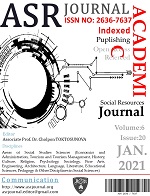Author :
Abstract
Filipinler'in altıncı en büyük ve dördüncü en kalabalık adası olan Panay, Visayas Adalar Grubu’ndaki en büyük yüzölçümüne sahip olanıdır. Panay Adası, 4 eyaleti, 3 kenti ve 91 ilçeyi kapsamaktadır. Panay Adası’nın kuzeyinde Sibuyan Denizi, doğusunda Visayan Denizi ve güneyinde de Sulu Denizi yer almaktadır. Adanın kuzeydoğusunda yer alan Hinto-Olo Boğazı Panay’ı Masbate Adası’ndan ayırır. Adanın güneydoğusunda yer alan İloilo Boğazı Panay’ı Guimaras Adası’ndan ayırır. Panay, dağlık, orta gelişmiş ve seyrek nüfuslu bir Filipin Adası olarak tanımlanabilir. Bu araştırmada Panay Adası’nın coğrafi konumu, doğal ve beşeri özellikleri açıklandığı gibi turizm çekicilikleri ve doğa koruma alanları da kısaca ele alınmıştır. Adanın başlıca kentleri, şelaleleri, mağaraları, akarsuları, kıyı adaları, inanç merkezleri ve tarihsel-kültürel çekicilikleri irdelenerek adanın turizm potansiyeli resmedilmeye çalışılmıştır. Çalışmada hem adanın başlıca konaklama tesisleri ve plajları hem de adanın yakın çevresinde yer alan turizm merkezleri irdelenmiştir.
Keywords
Abstract
Panay, which is the sixth largest and fourth most populous island in the Philippines, is the one with the largest surface area within the Visayas Islands Group. The Panay Island is composed of 4 states, 3 cities and 91 districts. There is the Sibuyan Sea in the north, the Visayan sea in the east and the Sulu Sea in the south of the Panay Island. The Hinto-Olo strait, located in the northeast of the island, separates Panay from the Masbate Island. The Iiloilo strait, located in the southeast of the island, separates Panay from the Guimaras Island. It is possible to describe Panay as a mountainous, middle-developed and sparsely populated Philippine island. In the present study, the geographical location, natural and human characteristics of the Panay Island have been explicated; also the touristic attractions and natural conservation areas have been briefly discussed. We have tried to identify the tourism potential of the island by examining the major cities, waterfalls, caves, rivers, coastal islands, faith centers and historical-cultural attractions. In this study, both the main accommodation facilities and beaches of the island and the tourism centers in the immediate vicinity of the island have been examined.
Keywords
- Atalay, İ., Resimli ve Haritalı Dünya Coğrafyası. İstanbul: İnkılâp Kitabevi, 2001.
- Atalay, İ., Resimli ve Haritalı Dünya Coğrafyası. İstanbul: İnkılâp Kitabevi, 2001. Atalay, İ., Kıtalar ve Ülkeler Coğrafyası. İzmir: META Basım, 2007.
- Atasoy, E., Demografi Yazıları. Bursa: MKM Yayınları, 2010.
- Atasoy, E., Kıtalar ve Ülkeler Coğrafyası. Bursa: Ezgi Kitabevi Yayınları, 2010.
- Atasoy, E., “Muslim Communities in the Philippines from the Perspective of Political Geography and Etnogeography”. Journal of History Culture and Art Research, Vol. 7, No. 2, June, 2018.
- Bayar, S., Filipinler Ülke Raporu, T.C. Başbakanlık Dış Ticaret Müsteşarlığı İhracatı Geliştirme Merkezi, Ankara, 2011.
- Colleen, A. S., “Philippines in Pictures”, Manila, Library of Congress Catakoging, Cilt 1, 1967.
- Düzyol, T., Filipinler, Ermağan, İsmail (Editör), “Dünya Siyasetinde Doğu Asya, Nobel Yayınları, 2016.
- Georgiev, P., “Filipinite i Evraziyskata Dıga na Nestabilnost, Spisanie Geopolitika”, Broy 6, Sofya, 2005.
- Krıstev, V., “Geopolitika i Geostrategiya na Turizma, İzdatelstvo Nauka i İkonomika”, İkonomiçeski Universitet, Varna, 2016.
- Krıstev, V., “Geografiya na Turizma, İzdatelstvo Nauka i İkonomika”, İkonomiçeski Universitet, Varna, 2014.
- Lakost, İ., Geopolitiçeski Reçnik na Sveta, Izdatelska Kaşta Trud, Sofiya, 2005.
- Lavrov, S. B. & Kaledin, N. V., Ekonomiçeskaya, Sotsialnaya i Politiçeskaya Geografiya Mira. Regioni i Strani, İzdatelstvo Gardariki, Moskova, 2003
- Lopez, M. L., A Handbook of Philippine Folklore, Quezon City, The University of the Philippines Press, 2006.
- Lukanov, A., Bojinov, N., Dimitrov, S., “Stranite v Sveta 2005-2006”, İzdatelstvo Gloriya Palas, Sofya,Manalo J. J. P., “Relevance Of Sustaınable Tourısm In The Phılıppınes: Case Of Boracay Island And PuertoPrıncesa Cıty”, International Journal of Information Research and Review, Vol. 04, Issue, 01, 2017, pp.3558-3562, January.
- Manuela W. S., “The İmpact of Government Failure on Tourism in The Philippines”, Transport Policy, Volume 43, October 2015, Pages 11-22
- Özey, R., Asya Coğrafyası. İstanbul: Aktif Yayınları, 2008.
- Özgüç, N., Turizm Coğrafyası. Özellikler ve Bölgeler. İstanbul: Çantay Kitabevi, 2011.
- Santos, R. B. Tomeldan M. V. (2009). Case-Based Study of Three Tourism Dependent Islands in thePhilippines The Cases of Boracay Island, Aklan; Puerto Galera, Oriental Mindoro; & Coron, Palawan in thePhilippines, A Journal of Architecture, Landscape Architecture and the Designed Environment University of the Philippines College of Architecture, Issue No: 3, Philippines.
- Shah K. Gupta V. Edited by Charlotte Boyd. (2000) “Tourism, the Poor and Other Stakeholders: Experiencein Asia”, Overseas Development Institute, Fair Trade in Tourism Project, University of North London, University of North London, UK, Printed by Russell Press Ltd, Nottingham, NG6 0BT, April.
- Thompson B. S. Clubbe C. P. Primavera J. H. (2014). “Locally Assessing The Economic
